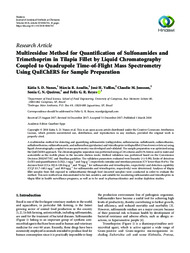Multiresidue method for quantification of sulfonamides and trimethoprim in tilapia fillet by liquid chromatography coupled to quadrupole time-of-flight mass spectrometry using QuEChERS for sample preparation.
Multiresidue method for quantification of sulfonamides and trimethoprim in tilapia fillet by liquid chromatography coupled to quadrupole time-of-flight mass spectrometry using QuEChERS for sample preparation.
Author(s): NUNES, K. S. D.; ASSALIN, M. R.; VALLIM, J. H.; JONSSON, C. M.; QUEIROZ, S. C. do N. de; REYES, F. G. R.
Summary: Abstract: A multiresidue method for detecting and quantifying sulfonamides (sulfapyridine, sulfamerazine, sulfathiazole, sulfamethazine, sulfadimethoxine, sulfamethoxazole, and sulfamethoxypyridazine) and trimethoprim in tilapia fillet (Oreochromis niloticus) using liquid chromatography coupled to mass spectrometry was developed and validated. The sample preparation was optimized using the QuEChERS approach. The chromatographic separation was performed using a C18 column and 0.1% formic acid in water and acetonitrile as the mobile phase in the isocratic elution mode. Method validation was performed based on the Commission Decision 2002/657/EC and Brazilian guideline. The validation parameters evaluated were linearity (r>=0.99); limits of detection (LOD) and quantification (LOQ), 1 ng·g-1 and 5 ng·g-1, respectively; intraday and interdays precision (CV lower than 19.4%). The decision limit (CC alfa 102.6-120.0 ng·g-1 and 70 ng·g-1 for sulfonamides and trimethoprim, respectively) and detection capability (CC beta 111.7 140.1 ng·g-1 and 89.9 ng·g-1 for sulfonamides and trimethoprim, respectively) were determined. Analyses of tilapia fillet samples from fish exposed to sulfamethazine through feed (incurred samples) were conducted in order to evaluate the method. This new method was demonstrated to be fast, sensitive, and suitable for monitoring sulfonamides and trimethoprim in tilapia fillet in health surveillance programs, as well as to be used in pharmacokinetics and residue depletion studies.
Publication year: 2018
Types of publication: Journal article
Unit: Embrapa Environment
Observation
Some of Embrapa's publications are published as ePub files. To read them, use or download one of the following free software options to your computer or mobile device. Android: Google Play Books; IOS: iBooks; Windows and Linux: Calibre.
Access other publications
Access the Agricultural Research Database (BDPA) to consult Embrapa's full library collection and records.
Visit Embrapa Bookstore to purchase books and other publications sold by Embrapa.

